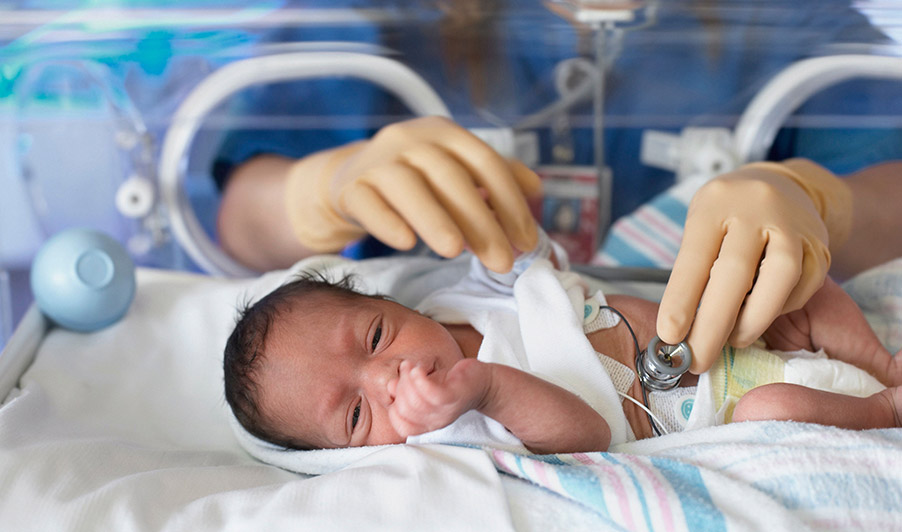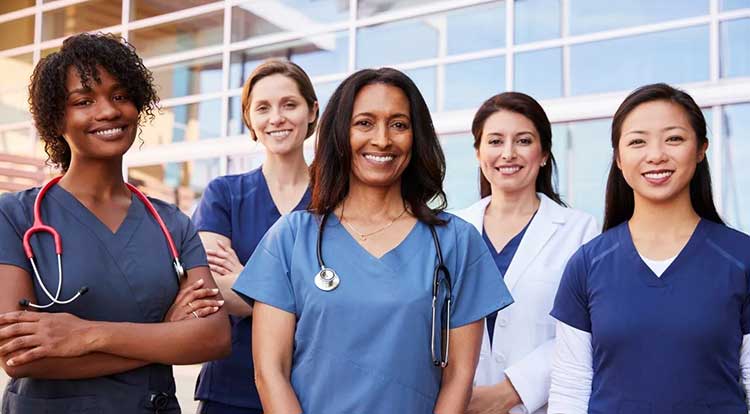What are Birth Complications?
Birth complications refer to any type of harm or damage to the baby that may occur during the pregnancy or around the time of labor and delivery. Birth complications statistics reveal that their incidence is on the rise in the United States. From 2014 to 2018, researchers noted a 14% jump in the rate of birth complications.
When birth complications definitions are broadened to include all types of birth defects, the data is more alarming. According to the CDC, every 4 ½ minutes, a baby in the US is born with a birth defect. Notably, complications of premature birth (or preterm complications) are among the more common complications of labor and delivery.

Serious birth complications for baby often occur due to oxygen deprivation to the brain, which can cause hypoxic-ischemic encephalopathy (HIE) and may lead to cerebral palsy.
Common Birth complications that cause a severe birth injury or brain damage may include:
- Birth asphyxia from fetal distress
- Severe birth trauma from prolonged labor
- Maternal infections: Group B strep infection (leading to meningitis or septicemia)
Causes of birth complications are wide-ranging. But medical studies have demonstrated that many conditions leading to birth complications can be diagnosed and treated successfully. Unfortunately, when medical negligence results in delayed diagnosis, misdiagnosis, or lack of timely and proper treatment, the baby may suffer severe health consequences from the resulting birth complications.
What are Common Birth Complications?
Cerebral palsy refers to a group of neurological disorders that may impact a child’s ability to move, use muscle coordination, and maintain posture and balance. Cerebral palsy may sometimes occur when the medical team fails to perform a timely cesarean section, or makes other medical errors that cause brain damage leading to CP.

Hypoxic-ischemic encephalopathy is a type of birth complication that occurs when the baby’s brain is deprived of oxygen. HIE usually occurs during the birthing process. Babies with severe HIE may experience developmental delays, cognitive defects, or conditions, such as cerebral palsy, which can have severe lifelong consequences.
Fetal distress is term used to describe a birth complication when the baby does not receive adequate oxygen and essential nutrients before birth. During labor contractions, there is a temporary blockage of the oxygen delivered to the baby from the mother. Fetal distress can occur when this oxygen deprivation becomes prolonged.
Around the time of birth, if an unborn baby or newborn suffers from oxygen deficiency, the resulting birth complication may be described as hypoxia. When the oxygen supply around the time of birth is completely cut-off, it is termed as anoxia. Cerebral palsy is one of the most serious potential consequences when the baby suffers from anoxia or hypoxia.
When the blood flow to the baby’s vital organs becomes restricted, the condition is clinically known as Ischemia. Infant brain ischemia or neonatal hypoxia-ischemia is usually a preventable birth complication, which occurs when the oxygen-rich blood does not flow sufficiently to the brain around the time of birth. Infant brain ischemia is a key cause of cerebral palsy.
Neonatal seizures or convulsions are said to occur when a baby suffers from epileptic fits during the neonatal period (first 4 weeks of birth). Neonatal seizures are usually a consequence of prolonged fetal distress during the labor and delivery process. Babies with this birth complication also have an increased risk of hypoxic-ischemic encephalopathy, leading to cerebral palsy.
Brain injury in babies is a birth complication that may occur during pregnancy or around the time of labor and delivery. In many cases, the symptoms of this brain damage to the baby may manifest later in life, marked by developmental delays. Hypoxic-ischemic encephalopathy (HIE) is the leading major birth-related brain injury and is the leading cause of cerebral palsy.

The blood of the mother and the baby is usually compatible, but sometimes a “rhesus factor disorder” or “Rh incompatibility” may develop when the mother is Rh negative and the baby in the womb is Rh positive. This can make the mother’s blood toxic to the baby if certain treatment is not performed prior to birth. Rh incompatibility exposes the baby to the risk of serious birth complications, such as brain damage, seizures, and hydrops fetalis (fluid build-up and swelling).
Meconium aspiration syndrome is a birth complication that occurs when the baby’s first feces (meconium) mixes with the amniotic fluid and reaches their lungs. Fetal distress, hypoxia, maternal infection, or prolonged or arrested labor may cause the baby to gasp for breath, resulting in meconium inhalation, which can cause serious complications or even the baby’s death.
Neonatal hypoglycemia is a birth complication that develops when the baby’s blood glucose levels are dangerously low after birth. Neonatal hypoglycemia may develop during pregnancy due to maternal malnutrition or during the birthing process due to other birth complications including fetal distress or HIE. Babies are high at a risk of brain damage, which may eventually lead to cerebral palsy when neonatal hypoglycemia is diagnosed late or improperly treated.
Fetal acidosis occurs when the in-utero baby has excessive concentration of acid and hydrogen ions in the blood. This high level of toxicity in the blood can cause oxygen deprivation, resulting in cellular damage to the brain and other vital organs. Fetal acidosis is one of indicators that the baby may have suffered the birth complication HIE during the labor and delivery process and can lead to cerebral palsy.
When the heart rate of an unborn baby is abnormally low (below 120 beats per minute), it’s referred to as fetal bradycardia. A low heart rate of the baby during pregnancy indicates fetal distress. When fetal bradycardia is severe with the baby’s heart rate is below 100 beats per minute, it increases the risk of birth complications, such as HIE and cerebral palsy.
Gestational diabetes mellitus may develop in an expectant mother when she has higher than normal blood glucose levels. This usually develops during pregnancy and resolves following delivery of the baby. Gestational diabetes increases the risk of birth complications, such as preeclampsia, fetal macrosomia, fetal hypoglycemia, respiratory distress, prolonged labor, cephalopelvic disproportion, HIE, and cerebral palsy.
Newborn jaundice occurs when a baby’s bilirubin levels in the blood are abnormally high. Bilirubin is the substance that causes yellow discoloration in the eyes and skin. When the levels of bilirubin are excessive and prolonged, it can lead to a birth complication called kernicterus. When kernicterus occurs, bilirubin reaches the baby’s brain, causing brain damage and cerebral palsy.
Premature separation of the placenta from the uterine lining is a birth complication called placental abruption. When a placental abruption occurs, the placenta is no longer able to supply enough oxygen to the baby, which creates immediate fetal distress. Placental abruption is an emergency birth complication where a c-section must be performed or the baby will suffer a brain injury including hypoxic-ischemic encephalopathy (HIE) and cerebral palsy.

When labor contractions last for 20 hours or more or the mother’s pushing fails to progress to a delivery, the prolonged labor occurs. If the labor progress has completed ceased, the condition is called arrested labor. In both these birth complications, the baby’s risk of developing HIE from fetal distress or birth trauma increases, which can lead to cerebral palsy, developmental delays, seizures, and cognitive problems.
The uterus, which holds the unborn baby, is made of three muscle layers: endometrium (inner layer), myometrium (middle layer), and perimetrium (outer layer). When the uterus ruptures or splits through these layers, the birth complication is known as uterine rupture. The risk of uterine rupture is the highest when a vaginal birth after cesarean (VBAC) is attempted. A uterine rupture is a medical emergency which requires an immediate emergency c-section to prevent the baby from suffering a catastrophic brain injury.
When an expectant mother undergoes a vaginal delivery after she has previously delivered a baby by cesarean section, the procedure is known as a vaginal birth after cesarean (VBAC). Uterine rupture is the primary birth complication that may occur in case of a failed VBAC, which can pose risk to the lives of both the mother and the baby. A VBAC is a risky route for an obstetrician to take that puts the baby at high risk of a birth injury and certain precautions must be taken when this choice is made.
Anesthesia errors during the birthing process include anesthetic overdose, inappropriate anesthesia technique, intubation errors, incorrect fetal heart rate monitoring, or communication failure between the anesthesiologist and other members of the perinatal team. Fetal distress, fetal acidosis, fetal hypoxia, HIE, and cerebral palsy are common birth complications due to anesthesia errors.
In case of prolonged or arrested labor, the medical providers may sometimes attempt to induce labor with drugs, such as Pitocin and Cytotec. Incorrect use of these drugs or a failure to properly monitor the baby when these drugs are administered can lead to birth complications, such as fetal hypoxia, ischemia, HIE, and cerebral palsy.
High blood pressure condition in an expectant mother in the later stages of pregnancy is termed as preeclampsia. This condition restricts the placenta’s ability to deliver oxygenated blood and vital nutrients to the baby, increasing the risk of birth complications, such as IUGR (intra-uterine growth restriction) Severe preeclampsia may also lead to birth asphyxia, HIE, and cerebral palsy.
Group B streptococcus is one of the most common bacterial infections during pregnancy, affecting about 25% of all expectant mothers. Maternal infections, such as Group B strep are associated with the occurrence of very early premature birth as well as neonatal complications that may require the use of neonatal resuscitation. Unless the infection is diagnosed early and treated aggressively, it may lead to birth complications, such as HIE and cerebral palsy.
When the doctors and nurses determine that an expectant mother may not be in a position to have an unassisted delivery, they may sometimes undertake an assisted vaginal delivery using forceps and vacuum extraction tools. Mistakes in the use of these devices may lead to birth complications, such as skull fracture from birth trauma, brain bleeds, spinal cord damage, seizures, and facial (Bell's Palsy) or Erb’s palsy.
PVL is damage to the inner part of the baby’s brain (white matter), around the ventricles that contain cerebrospinal fluid. Premature babies are at a higher risk of PVL. Babies with this birth complication are also at an increased risk of intra-ventricular hemorrhage, sepsis, seizures, respiratory distress syndrome (RDS), and cerebral palsy.
Umbilical cord related birth complications may occur during pregnancy or at the time of labor and delivery. Prolapsed umbilical cord is one of the more serious umbilical cord problems, which occurs when one or more cord loops slip through the cervix prior to the baby, causing cord compression. Umbilical cord compression (including a nuchal cord—meaning wrapped around the neck) can cut off the oxygenated blood flow to the baby, leading to HIE and cerebral palsy.
HELLP syndrome is a potentially life-threatening disorder that causes low platelet count and elevated liver enzymes in the expectant mother’s blood. In the absence of a timely diagnosis and treatment, HELLP syndrome can lead to birth complications for the baby, including IUGR, placental abruption, intra-ventricular hemorrhage, fetal hypoxia, premature birth, HIE, and cerebral palsy.
When a baby is born before the gestational age of 37 weeks, it is called a premature birth. Preterm birth and low birth weight complications are responsible for about 17% of infant deaths within the first year after birth. In particular, babies born before 32 weeks of pregnancy are at an increased risk of birth complications, such as developmental delays, HIE, and cerebral palsy. Prompt and attentive neonatal care is critical to minimize the risks of these birth complications.

Cephalopelvic disproportion or CPD occurs when the baby’s head size is too big to fit through the mother’s pelvis. This can cause prolonged or arrested labor, increasing the risk of fetal distress. Failure to diagnose and treat CPD or a delay in performing an emergency cesarean delivery can result in birth complications, such as fetal hypoxia, HIE, and cerebral palsy.
Oligohydramnios refers to abnormally low levels of amniotic fluid volume during pregnancy in proportion to the baby’s gestational age. Amniotic fluid is vital for the baby in the womb to support safe baby movements and promote the development of the baby’s digestive and respiratory systems. Birth complications of oligohydramnios may include umbilical cord prolapse, meconium aspiration syndrome, premature birth, IUGR, HIE, and cerebral palsy.
When the placenta covers the cervix fully or partially during pregnancy, the condition is known as placenta previa. An ultrasound test can diagnose placenta previa early in the pregnancy. In absence of timely detection and treatment or an emergency c-section, placenta previa can cause birth complications, such as fetal distress, HIE, and cerebral palsy.
When rupture of membranes (ROM) occurs after 37 weeks of pregnancy but before the start of labor, it is called PROM. If ROM occurs prior to 37 weeks of gestation, it is called preterm PROM (PPROM). Birth complications associated with PROM and PPROM include fetal distress, maternal infection, respiratory distress syndrome, fetal malpresentation, PVL, umbilical cord prolapse, HIE, and cerebral palsy.

Frequently Asked Questions
What is a birth complication?
A birth complication refers to an impairment of the baby’s body structure or function following an adverse medical event during pregnancy, labor, or delivery.
What complications can occur after birth?
Complications after birth may be divided into three broad categories: (a) brain damage; (b) nerve damage; and (c) orthopedic damage. Complications after birth may range widely from seizures to cerebral palsy to the baby’s death.
Are complications during birth common?
Yes, complications during birth are relatively common in the United States. According to the CDC, about 3% of all babies in the US are born with birth defects. The number increases to about 5% within the first 12 months.
What is the number one complication of childbirth?
Cerebral palsy is the number one complication of childbirth. When the fetal brain is deprived of oxygen, it can result in hypoxic-ischemic encephalopathy (HIE), which sometimes leads to cerebral palsy in babies.
What is the most common complication of childbirth?
Prolonged labor or arrested labor is the most common complication of childbirth. This complication can sometimes lead to cerebral palsy. Premature birth, PROM, preeclampsia, and Group B strep maternal infection are some other common complications of childbirth.
Can birth complications be caused by the medical malpractice of doctors and nurses?
Yes, many birth complications are preventable when attentive medical diagnosis, care and treatment is received during the labor and delivery and the period shortly after birth called the “neonatal” period. If doctors and nurses fail to follow the “standard of care” (meaning acceptable medical decision-making and treatment) then they can be held liable if their negligence (“violation of the standard of care”) causes a birth complication and injury.
Can epilepsy start as an adult from a birth complication?
Yes, according to the CDC, some birth complications may lead to epilepsy in adults.
What are the most common birth complication that arise at the time of birth?
The predominant complication factors that may arise at birth include: (1) birth complications caused by oxygen deprivation; (2) birth complications caused by premature birth; (3) birth complications caused by infection; and (4) birth complications caused by trauma.
Is Your Child’s Birth Complication the Result of Medical Malpractice?
Parents whose children suffer from birth complications want and deserve answers as to cause of their child’s complication and whether mistakes by the doctors and nurses contributed to the complication.
- Were there signs of a birth complication during the pregnancy, labor, and delivery process, or presence of risk factors, which were either not recognized or properly treated?
- Did the medical team fail to order a series of tests to diagnose a suspected complication in a timely manner?
- Was the decision to perform a cesarean delivery delayed?
- During the labor and delivery, were there clear indications that the baby was suffering from fetal distress, but appropriate actions were not taken by the obstetrician or nurses?
- Did the neonatal resuscitation team delay in providing important breathing support after birth?
- Were serious neonatal conditions like fetal hypoxia, hypoglycemia, or jaundice missed or treated incorrectly?
The experienced birth injury lawyers at Miller Weisbrod Olesky will help you determine if mistakes of the medical providers caused a birth injury to your child. Our hard working and successful birth injury attorneys have represented families all over the United States in their time of need after a birth injury. We use our experience and expertise to obtain for you and your child a medical malpractice settlement that will help provide specialized medical therapy in order to maximize the quality of life and independence of your child throughout their life.
Sometimes families are reluctant to contact a medical malpractice lawyer. It’s also not uncommon for parents to feel overwhelmed by the responsibilities they encounter in caring for their injured child and worried that they will not be able to help out in a lawsuit involving their child’s birth injury. Our birth injury attorneys and nursing staff will address these hesitations and concerns, so you can focus on your child and maximizing their care.
Registered Nurses and Nurse-Attorneys Are a Vital Part of Our Birth Injury Team…and Yours

Most national birth injury law firms will employ one or two nurses to assist the review of cases and medical research. But Miller Weisbrod Olesky offers an unmatched number of nurses and nurse-attorney employees support to both the birth injury attorneys and our clients.
Our team of registered nursing staff and nurse-attorneys bring a deep level of medical and personal insight to every client’s case. Our nursing team includes both an experienced labor and delivery nurse as well as an ICU nurse. Working closely with the rest of the team, they investigate the reasons behind a birth injury and how medical professionals breached their standard of care.
Meet our Legal Nursing Team
Linda Chalk

As a registered nurse, Linda practiced ICU nursing for 44 years while caring for a wide range of patient conditions. She has worked closely with founding partner Les Weisbrod for over 30 years, investigating and pursuing birth injury cases.
Along with DJ Weisbrod, Linda heads up the firm’s birth injury intake, screening, and medical literature research team. She personally screens all potential cases to ensure that medical issues have been addressed before we file lawsuits on behalf of birth-injured children and their families.
DJ Weisbrod

Before joining Miller Weisbrod, DJ practiced as a surgical nurse in various hospital and operative settings. She has been with the firm over 30 years.
DJ directs Miller Weisbrod’s birth injury intake and medical screening team. She has also served as firm founder Les Weisbrod’s trial nurse for all cases involving medical negligence and birth injury.
Linda Cuaderes

Linda Cuaderes is both a registered nurse and a licensed lawyer. Linda works exclusively in Miller Weisbrod’s Birth Injury and Medical Malpractice section. Linda acts as the firm’s patient advocate and liaison with our young clients and their parents.
Linda combines her legal and nursing experience along with her exceptional organizational talent and attention to detail to make sure each child we represent is provided the highest level of medical care and attendant care during the pendency of their case. Linda communicates with our parent clients regularly to monitor their birth injured child’s treatment, provide guidance as to additional care and therapies and when necessary assist them in obtaining specialized medical providers.
Linda was raised in Bartlesville, Oklahoma and completed her Bachelor of Science in Nursing with Honors at the University of Oklahoma. She started as an Oncology Nurse at Presbyterian Hospital in Oklahoma City, quickly becoming the Assistant Head Nurse of the Outpatient Endoscopy Unit. Linda then entered the University of Oklahoma College of Law.
Following graduation, Linda joined Les Weisbrod in the Medical Malpractice Section. After taking time off to raise her three lovely children, Linda returned to Miller Weisbrod and her passion of holding healthcare providers accountable for preventable errors. Linda is active in the American Association for Justice, Texas Trial Lawyers Association, Dallas Trial Lawyers Association, and the Texas Bar Association. Linda is an active member of the Birth Trauma Litigation Group and Medical Negligence Section of the American Association for Justice.
She is admitted to practice before the Texas Supreme Court and routinely works on cases pending throughout the United States. Linda has worked with child victims of birth injury, their parents and other victims of medical malpractice in Texas, New Mexico, Oklahoma, Arkansas, Louisiana, Iowa, Ohio, New York, Alabama, Georgia, Arizona, Utah and Missouri.
Education
- University of Oklahoma - School of Law, 1990, J.D. - Norman, Oklahoma
- University of Oklahoma - School of Nursing, 1985 - Norman, Oklahoma
Areas of Practice
- Birth Injury/Birth Trauma
- Medical Malpractice
Associations & Memberships
- Texas Bar Association
- American Association of Justice
- Texas Trial Lawyers Association
- Dallas Trial Lawyers Association
Kristin Jones

Kristin combines her medical and legal training to provide invaluable, passionate service to parents struggling to care for their birth-injured children.
Families often have questions as they go through the birth injury lawsuit process. Kristin diligently identifies and investigates all medical issues so the birth injury attorneys at Miller Weisbrod can answer those questions Kristin ensures that our birth injured children’s medical records are thoroughly reviewed and organized. Miller Weisbrod’s birth trauma litigation attorneys and medical experts retained by the firm need her services while pursuing justice for our clients.
Kelly Kunkel

Kelly Kunkel was born and raised in Dallas, Texas. She has 15 years’ experience in hospital based High Risk Obstetrics and Labor and Delivery bedside nursing care. Kelly graduated with an Associate’s Degree in Nursing from El Centro College in December of 1990 and received her Bachelor’s Degree in Nursing from West Texas A & M University in 2008; graduating with honors.
In addition, Kelly has over 25 years’ experience in medical malpractice case management and litigation and has worked with David Olesky for over 22 years. After many years of assisting in defending healthcare providers and hospital systems in medical malpractice cases involving complex litigation matters related to birth injury, catastrophic injury and death, Kelly has proudly joined David Olesky in the national birth injury and medical negligence practice at Miller Weisbrod Olesky.
Why Should You Talk with the Knowledgeable Attorneys at Miller Weisbrod Olesky?

The only way to find out if you have a birth injury case is to talk to a lawyer experienced in birth injury lawsuits. It’s not uncommon that a birth related complication results in a preventable birth injury, including cerebral palsy, but it takes a detailed expert review by a birth injury attorney of the medical records from your child’s birth to determine if the birth injury was the result of medical malpractice.
At Miller Weisbrod Olesky, a team of committed lawyers, nurses and paralegals uses our detailed medical negligence case review process to assess your child’s potential birth injury case. We start by learning more about you and your child and the status of meeting/missing developmental milestones. Then we gather medical records to determine what happened before, during, and after your delivery. We call in skilled medical experts who review your records and let us know if they think medical errors could have caused your child’s injuries.
If we feel medical negligence caused or contributed to your child’s injuries, we meet with you to discuss how you can receive compensation from the medical professionals who made the errors. Our birth injury attorneys have recovered millions of dollars in settlements for families of children that have suffered a birth injury.
At no point in our legal intake process will we ask you to pay anything. The medical review of your case and the consultation are free. We only receive payment when you do.
